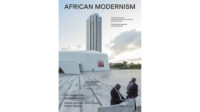‘Tropical Modernism’ Surveys Climate-Responsive Architecture in Post-Colonial West Africa and India

-Victoria-and-Albert-Museum-London-(5).webp?t=1711391524&width=1080)
-Victoria-and-Albert-Museum-London-(22).webp?t=1711391554&width=1080)
Installation view of Tropical Modernism: Architecture and Independence at the V&A Kensington's Porter Gallery. Photo © Victoria & Albert Museum, London
-Victoria-and-Albert-Museum-London-(18).webp?t=1711391569&width=1080)
Installation view of Tropical Modernism: Architecture and Independence at the V&A Kensington's Porter Gallery. Photo © Victoria & Albert Museum, London
-Victoria-and-Albert-Museum-London-(16).webp?t=1711391581&width=1080)
Installation view of Tropical Modernism: Architecture and Independence at the V&A Kensington's Porter Gallery. Photo © Victoria & Albert Museum, London

-Victoria-and-Albert-Museum-London-(5).webp?t=1711391524&width=150)
-Victoria-and-Albert-Museum-London-(22).webp?t=1711391554&width=150)
-Victoria-and-Albert-Museum-London-(18).webp?t=1711391569&width=150)
-Victoria-and-Albert-Museum-London-(16).webp?t=1711391581&width=150)
-Gordon-Cullen-Estate.webp)
Illustration from The Architectural Review, 1953. Image courtesy RIBA Collections © Gordon Cullen Estate
“The wind of change is blowing through this continent,” declared British Prime Minister Harold Macmillan in the Ghanaian capital Accra in 1960. “Whether we like it or not, this growth of national consciousness is a political fact.” Formerly the Gold Coast, its shoreline dotted with the relics of forts from the transatlantic slave trade, Ghana was the first sub-Saharan African nation to gain its sovereignty in 1957.
Led by the charismatic Kwame Nkrumah, Ghana embarked on a vigorous program of nation-building, employing Modernist architecture to express political and cultural ambitions and concretize Nkrumah’s vision of a Pan-African future. A decade earlier, India had finally achieved independence and its first Prime Minister, Jawaharlal Nehru, was equally eager to modernize, commissioning Le Corbusier to design the new city of Chandigarh.

Film still of Mfantsipim School, Cape Coast, by Fry, Drew Partners for Tropical Modernism: Architecture and Independence. Image © Victoria and Albert Museum, London.
Developed from an exhibition first shown at the 2023 Venice Biennale, Tropical Modernism—on view at the Victoria & Albert Museum (V&A) in South Kensington, London—deftly unpicks the threads and experiences of the postwar era to show how Modernism took root in Ghana and India following independence from Britain. Through a compelling array of drawings, models, photographs, films, and ephemera, it examines how Western ideas were reimagined as a form of post-colonial nationhood that combined European practice with indigenous traditions of making and design, while valorizing the contributions of historically neglected figures.
.webp)
Black Star Square, Accra, by Ghana Public Works Department. Film Still from Tropical Modernism: Architecture and Independence. Image © Victoria & Albert Museum, London
Among them are the Sikh draughtsman and model maker Giani Rattan Singh, who worked closely with Le Corbusier, and Ghanaian architects John Owusu Addo and Victor Adegbite. Adegbite became the country’s chief architect, designing Black Star Square in Accra, the civic centerpiece of Ghana’s independence celebrations. The scheme encompassed a dramatic, double-arched gate framing the sea, conceived as an “arch of return” as opposed to the “door of no return” in colonial forts through which Africans were forced during the slave trade.

1

2
Jane Drew and Maxwell Fry with a model of one of their many buildings for the Gold Coast, 1945 (1); boy and concrete screen at University College Ibadan, Nigeria, 1962 (2). Photos courtesy RIBA
Underpinning the narrative is the influence of more familiar characters, notably English architects Maxwell Fry and Jane Drew. In the late 1940s, their research into generic forms of climate-tempered modern architecture suitable for the “humid zone,” featuring perforated screens, deep shading, and natural ventilation, impelled a lavishly funded postwar pacification program of schools, hospitals, and infrastructure in British West Africa (latter day Ghana, Nigeria, Sierra Leone, and Gambia). A Tropical School was established at London’s Architectural Association to train architects for practice in the colonies; John Owusu Addo was one of its alumni.
-FDL-ADAGP-2014.webp)
Le Corbusier in Chandigarh with the plan of the city and a model of the Modular Man, his universal system of proportion, 1951. Photo © FDL, ADAGP 2014
Fry and Drew were also instrumental in the realization of Chandigarh, suggesting that Le Corbusier design the modern state capital of Punjab, which had lost Lahore to Pakistan under partition in 1947. Chandigarh’s gridded layout and heroic concrete forms were the antithesis of Edwin Lutyens’ ponderous New Delhi, once described as “the tombstone of the British Raj.” But a film in the exhibition by Swiss director Alain Tanner brings home the backbreaking reality of Chandigarh’s unmechanized construction, with squads of male and female laborers hefting bowls of concrete up spindly ladders in the sweltering sun.
Subsequent generations of Indian architects absorbed the radical tenets of Chandigarh, but also sought out India’s vernacular heritage, transforming it through abstraction and technical advances in response to changing social realities. Post-independence Ghana pursued a similar path, with the establishment of the first architecture school south of the Sahara, known as the “Bauhaus of the tropics” in Kumasi.
But with economic difficulties mounting, Nkrumah’s regime became increasingly authoritarian and he was abruptly deposed in 1966. Modernism fell out of favor and with the advent of air conditioning, there was less need to rely on passive means of cooling. Yet as the climate emergency intensifies, the ideas behind Tropical Modernism, which represented clarion moments of opportunity in post-colonial history, have renewed relevance for developing new and more sustainable, less energy-intensive forms of architecture.

Diagram of a brise soleil at Aburi Girl’s School, Ghana, from Tropical Architecture in the Humid Zone, 1956, publisher B.T Batsford. Image courtsey RIBA
Tropical Modernism: Architecture and Independence
The Porter Gallery at V&A South Kensington, London
On view now through September 22





-Victoria-and-Albert-Museum-London-(5).webp)
-Victoria-and-Albert-Museum-London-(22).webp)
-Victoria-and-Albert-Museum-London-(18).webp)
-Victoria-and-Albert-Museum-London-(16).webp)